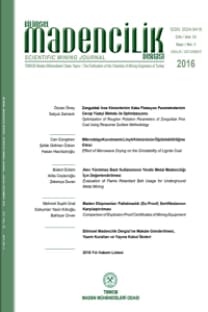Düşey Elektrik Sondajı Wenner Görünür Özdirenç Eğrilerinin İki Nokta Elektrod, Schlumberger, Dipor Eğrilerine ve Bu Elektrod Dizilimindeki Eğrilerin Wenner Görünür Özdirenç Eğrilerine Dönüştürülmesi İ
Daha Önceki çalışmamızda Başokur (1980)
düşey elektrik sondajı Schlumberger gö
rünür özdirenç eğrilerinden dipol, iki
nokta elektrod görünür özdirenç eğrilerinden
Schlumberger ve dipol eğrilerinin
lineer süzgeç yardımıyla elde edilmesi
için sine yanıt, elementer fonksiyonlar
cinsinden tanımlanmıştı. Yukarıda anılan
elektrod dizilimleri arasında geçişi sağlayan
süzgeç spektrumlan da belirlendiğinden,
ters yönde dönüşümü sağlayan süzgeç
spektrumlan ve spektrumlann ters
Fourier dönüşümüyle sine yanıt saptanabilir.
Bu yazı içerisinde ise, düşey elektrik
sondajı "Wenner görünür özdirenç eğrilerinden,
iki nokta elektrod, Schlumberger,
dipol eğrilerini ve bu elektrod dizilimlerindeki
eğrilerden, "Wenner eğrilerini sap-
tayan süzgeçlerin spektrumlan fonksiyon
olarak belirlenmeye çalışılmıştır. Bu
amaç için, Wenner İle Schlumberger ve
Wenner ile dipol görünür Özdirençleri
arasında birer bağıntı türetilmiştir.
Böylece, daha önceki çalışmamızla birlikte,
iki nokta elektrod, Wenner, Schlumberger
ve dipol elektrod dizilimlerinin
herhangibirine ait görünür özdirenç eğ
risini, diğer bir dizilimde elde etmeye yarayan
süzgeç spektrumlan tümüyle tanımlanmış
olur. Bu dört elektrod diziliminin
dışındaki elektrod dizilimleri için,
burada verilen bağıntılardan yeni süzgeç
spektrumlan bulunabilir.
Ayrıca, elektrod dizilimlerinin herhangi
biri için görünür özdirenci, dönüşük Özdirence
(resistivity transform) çeviren
süzgeç spektrumu belli ise diğer elektrod
dizilimleri için dönüşük özdirenci veren
süzgeç spektrumlan ve giriş - çıkış fonksiyonları
arasındaki yatay kaymalar yazıda
verilen bağıntılar kullanılarak kolayca
saptanabilir.
In my earlier work Başokur (1980), I have
defined the filter spectra by means of
function for transforming the apparent
resistivity in one configuration into that
in another configuration between the
two-electrode, Schlumberger and dipole
electrode configurations.
*
Also given are sine response functions for
converting the Schlumberger apparent
resistivity curves to dipole apparent resistivity
curves, from the two - point
elecrode apparent resistivity to the Schlumberger
and the two - point to the dipole.
'
In this paper, I obtained the filter spectra
as a function for converting the Wenner
apparent resistivity to the other elecrode
configurations (the two - point, the
Schlumberger and the dipole) and vice
versa.
For this purpose, suitable relatioships between
the Wenner and Schlumberger configurations
and between the Wenner and
dipole configurations are found.
In connection with my previous article, I
defined the filter spectra for converting
the apparent resistivity in one configuration
into that in another configuration
between the two - point electrode, Wenner,
Schlumberger and dipole configurations.
For the electrode configurations other
than these four configurations the new
filter spectra may be obtained starting
from the given relationships.
There is no need to use discrete Fourier
transforms of the input and the output
functions in order to evaluate the filter
spectrum for this kind of filter.
In addition to these, if the filter spectrum
for converting the apparent resistivity
to the resistivity transform for one configurations
is determined, then filter
spectrum for transforming the apparent
resistivity to the resistivity transform in
any electrode configuration and the horizontal
shift between the input and output
samples can be calculated using these results
with no other additional effort.
- ISSN: 2564-7024
- Yayın Aralığı: 4
- Yayıncı: TMMOB Maden Mühendisleri Odası
